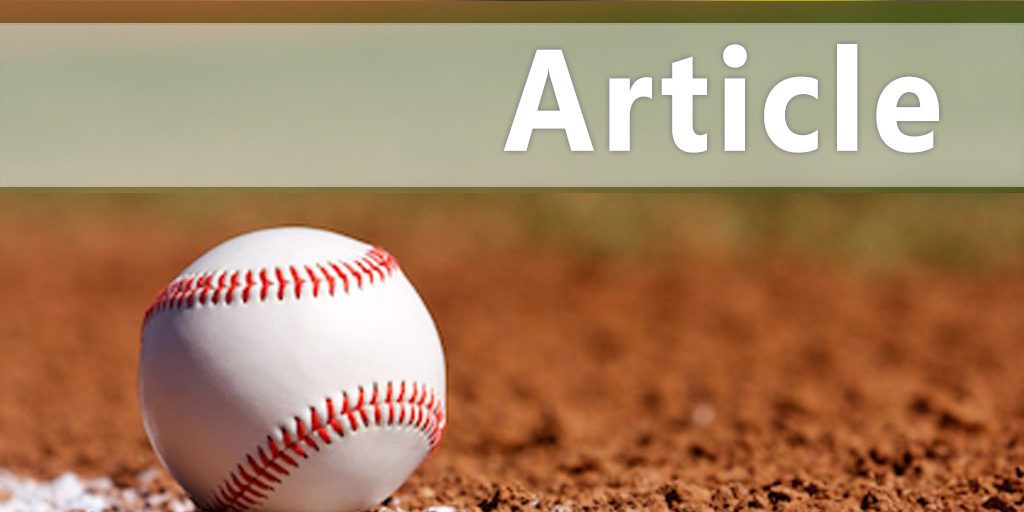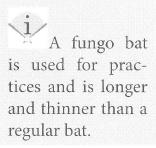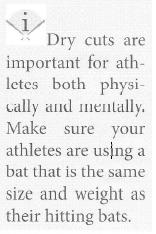|
Pre-Season Checklists
Physicals are required for every athlete to participate in a school sport. They are good for the entire school year, so the players who participated in a sport earlier in the year will not need another one, but you need to catch those individuals who didn't play another sport and do not have a current physical on file. Thirty days before the first practice, it's important to announce at school that anyone who is interested in trying out for baseball needs to have a physical done before the first practice (or tryouts). Do this at least once a week, each week prior to the first practice. Do not ever allow a player to try out to see if he makes the team before he gets a physical - you need to protect yourself from potential problems. If you allow a player to practice without a physical and he gets injured, you have just created a legal liability for yourself. You not only have the risk of legal action by the parents, but you can also be assured that your administrators will not be happy with you, either. There are certain rules that you must adhere to, and this is one of those rules. You should also post all requirements and expectations in the locker room 30 days before the first practice. Students don't always hear announcements, so - in writing - post the need to have a physical, and also include the time, date, and location of first practice. On that sheet, you should list how you want them to dress and the gear they will need in order to be prepared for practice. I suggest that you avoid making this a simple mundane list. Dress it up to make the boys excited for that first practice, as well as the season that will follow it. I always used this opportunity to post motivational quotes - not only on the bulletin board but also all around the locker room and my office. Any time someone entered my office, they immediately knew I was fired up about baseball. Sign-up sheets are valuable to get an idea of the numbers you can expect for the first practice. As players get their physicals, they can check off the box behind their name. My sign-up sheets also included a box for the students to write in their grade level, as well as a spot to check off an eye examination. Athletes' eyes can change after getting a physical, especially if they had a physical in August - that leaves six or seven months for a potential change in eyesight. The school nurse can do a routine screening to be on the safe side. I actually had an athlete whose eyes changed during the school year. When practices started, I couldn't understand why he all of a sudden couldn't judge a fly ball as a junior when he did a good job the previous year. He was about to lose his position in the outfield, but before he did, I made him visit the school nurse, who sent him to an optometrist, who gave him a new prescription for his glasses. I became a genius, and he went on to have a great season. Eye examinations became a must for all my players. Playbook Once the athletes are aware of the requirements for the first practice, it is time to start copying and assembling your playbook, which is more than just a book of team plays and signals. The following list has things you may want to include in your playbook: (I) Schedule for the season, including tournament schedules Rain Day: 3:30 - 5:30 and 3:30 - 5:45 - big gym (indoor practice) Wet Day: 3:30 - 5:30 - parking lot / gym (batting cage) Clear Day: 3:30 - 5:30 - at the field (post location and end time of practice 2:00 p.m. daily) (3) Required gear for practice: tennis shoes, spikes, glove, hat, specific pants, sleeves, etc. I never allow my teams to practice in shorts because the athletes need to protect their legs, especially when sliding and diving, and keep their leg muscles warm to help prevent muscle injury. Therefore, practice pants or sweats, hats, and sleeves are mandatory. In practice and games, I require sleeves for all players unless the temperature hit 80° because sleeves will keep their elbows and shoulders warm. Usually in the spring, the air is still cool, especially when there's a breeze. The outside temperature may be 70°, but with any amount of wind chill and a sweaty arm, they cool off fast. You don't want your athletes' muscles to get cold during games or practices because there will be an increased risk of injury. I make every effort to protect players' arms. After all, they can't get another arm at the dime store, so I take all precautions. Another reason is that I feel today's athletes are more vulnerable to weather conditions. In the era I grew up, our cars and homes did not have air conditioning, so we adapted to temperatures nature gave us. As a coach, you need to do your own research on weather and its effect on players' muscles and develop your personal philosophy on the subject of sleeves and injury prevention. (4) Team goals (6) Discipline code (7) Offense strategies: hitting stance, bunting target area (see examples in Chapter 8) (8) Defense strategies: cutoffs, relays, and defensive positioning for all situations at each position (see examples in Chapter 9) (9) Signs and signals (10) I like to scatter baseball photographs, motivational quotes, and short stories throughout the playbook. I have found that my athletes like this.  Put pride in your team playbook - it is a very useful tool to build team success. Equipment In final preparation for your first practice, it's time to get your batting cage, pitching machine(s), soft toss nets, sliding mat, and other equipment in a central location. Most schools will have multiple storage areas due to the size of your equipment. You need to go through the storage areas and organize the equipment so that everything is in its proper place and ready to use without wasting time when it comes to practice. The information below is broken into the two major types of equipment you'll need: indoor and outdoor. 1. Indoor batting cage with pitching machine and L-screen (I prefer a pitching machine, that throws real baseballs for the real game feel) An example of how you can set up stations with all this equipment in a high school gym for an indoor practice is in Chapter 6. Outdoor equipment 1. Outdoor batting cage You can be creative in how you acquire your equipment for practices Coaches devote a great deal of time to conditioning and arm care, but one area that is often overlooked is skin care. Growing up, my nose, ears, and neck frequently burned, which was usually followed by blisters and peeling skin. In the 60's, we thought the more sun we got, the more immune we became to sunburns. Unfortunately, that is not the case. In fact, the more sun you get, the more dangerous it is. Even people who can tan (and not just re-burn and blister) are at risk for skin disease. The Skin Cancer Foundation website states, "Melanoma is the most common form of cancer for young adults 25-29 years old and the second most common form of cancer for young people 15-29 years old:' The number of cases of skin cancer is on the rise every year, and many of the cases are being found in people younger and younger. It doesn't take much to increase your chances of getting skin cancer—just one bad blistering sunburn during childhood can double the risk of skin cancer later in life. The damage may not show up until an individual gets to be 40 or 50 years old, but the damage often occurs at a much younger age. In recent years, more research has been done due to the high occurrences of skin cancer. The most common are basal cell and squamous cell carcinomas; malignant melanoma is the least common but most dangerous. The sun's invisible rays that we really need to be concerned with are UVA and UVB. UVA rays can penetrate the skin more deeply where UVB rays are stronger - especially in the summer or in higher elevation. The sun's rays are strongest from 10:00 a.m. to 4:00 p.m., which means that your outdoor practices and games will often start while the rays are at their strongest. On top of that, baseball fields are commonly dirt and sand texture, which can reflect the sun's rays, making them even stronger. Don't let your players be fooled by thinking a cloudy day means they don't need sunscreen - the sun can still damage their skin through the clouds. Any sunscreen of SPF 15 or higher that protects from both UVA and UVB rays is highly recommended. With technology, we now have sunscreens that are waterproof and will not burn eyes when athletes sweat. Information pertaining to sunscreen is a perfect addition to your playbook; in fact, you may want to make sunscreen part of the required gear for players, especially in warm-weather and/or high-altitude states. One year I held a summer baseball camp for kids in Colorado, and several of my high school ball players went with me to help me run the camp. I told them before we left that they needed to pack sunscreen, especially since we were going to be outside all day in high elevation where the sun's rays would be stronger, and I reminded them the first morning of the camp that they needed to put sun-screen on. One player ignored my warnings and went the first day with no sunscreen, saying he would have a hat on and didn't need to worry about it. His neck got burned so badly from that one day that he couldn't even turn his head back and forth without a great deal of pain. And, even though he had a hat on, the field we were on was a dirt and sand mixture—the reflected rays gave him a sunburn on his face; while that sunburn wasn't nearly as bad as the direct rays on his neck, it does go to show that reflected rays can still cause damage. I cannot stress enough how important it is for players-and their coaches-to take care of their skin. For more information, you can visit the following helpful web- sites: Coppertone (www.coppertone.com), the American Cancer Society (www.cancer.org), Melanoma.com (www.melanoma.com), and the Skin Cancer Foundation (www.skincancer.org). Please take this subject seriously as it will affect your athletes for years to come. Pre-season meeting During the first few days of practice, I set up a pre-season meeting to meet with the athletes and their parents. I don't hold this meeting any earlier because, during those first few days, I still don't know who will be on the team - we're still in the tryout practices. The pre-season meeting date will be held shortly after tryouts (definitely before the first game of the season). Because it can be difficult to predict the weather in the spring, I provide two options for the meeting: If it's raining the day of the meeting (so our practice will be held indoors), our meeting will be held directly after the practice at 5:30 in the school gym; if it's clear on the day of the meeting (so our practice will be outside and last until 6:00), our meeting will be held at 6:30 in the school gym to give everyone plenty of time to get from the field to the school. At the pre-season meeting, I hand out the playbook - since this is the first time the players will be seeing the playbook for the season, I make sure I hold the meeting as soon as possible after the tryouts have ended to give them plenty of time with the book before the first game of the season. Also, at the meeting, I introduce myself, discuss my goals and expectations for the team, and go over the Code of Conduct I have set for the team. You will notice that at the bottom of the Code of Conduct I provide for you in this book, there are two signature lines: one for the parent and one for the player. The parents present at the meeting will sign the sheet (along with their athletes), and the form is turned in to me. For the parents who are not present (and invariably every season I have parents who are not), the athlete must return the sheet signed by himself and his parent before he can play in any games. The Code of Conduct is like a contract between me and my athletes and their parents. Just like you can't (and shouldn't) start working at a job before signing your contract, my players can't start playing in games until they've returned their Code of Conduct fully signed. The more prepared you are before the season begins, the more smoothly the season will run from an administrative perspective. Do what you know you can get done in the off-season (such as getting equipment and putting together your playbook) to save yourself some stress at the beginning of the season.
|
|
|




 (especially if your program doesn't have a large budget); for instance, I make cardboard lay-down bases for practice and use old bats for dry cuts. Never allow your athletes to use anything but a legal bat when hitting a ball; however, for dry cuts (when athletes practice swinging without hitting a ball), you can keep old bats on hand.
(especially if your program doesn't have a large budget); for instance, I make cardboard lay-down bases for practice and use old bats for dry cuts. Never allow your athletes to use anything but a legal bat when hitting a ball; however, for dry cuts (when athletes practice swinging without hitting a ball), you can keep old bats on hand.